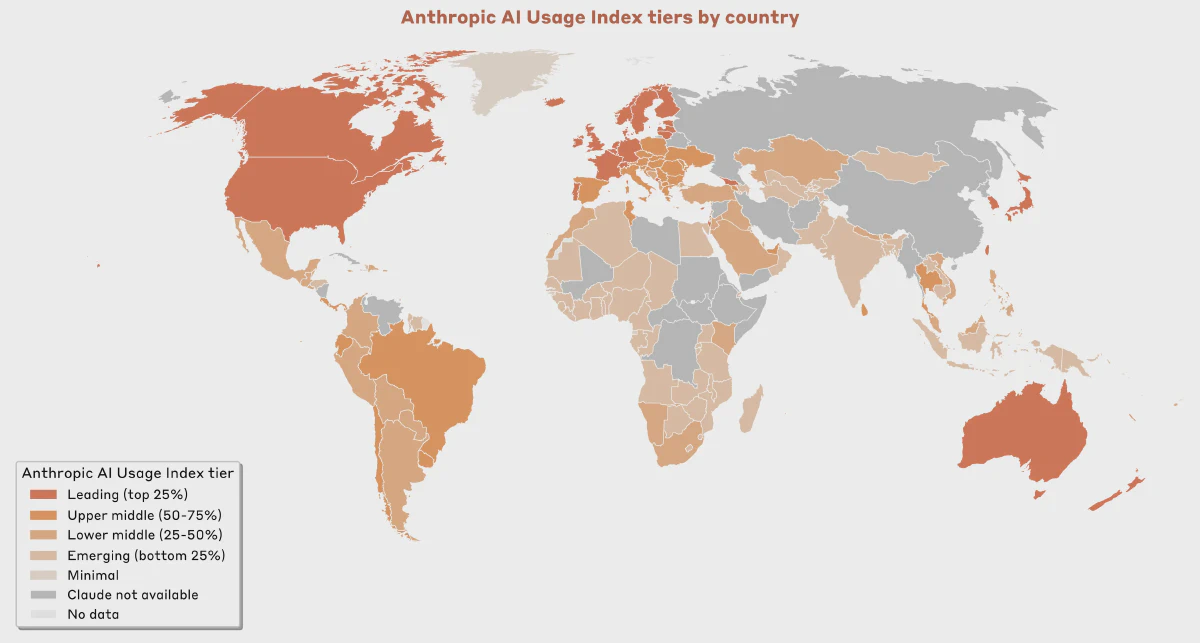Two years ago, only 20% of U.S. employees reported using AI at work. Today, that number is 40%. That’s not a gradual trend line, that’s a rocket ship. And according to the newly published Anthropic Economic Index (September 2025), this rapid adoption is reshaping industries, but not in the same way everywhere.
AI adoption is accelerating faster than any technology in modern history, but its benefits are concentrating in already-wealthy regions. We’re witnessing the early stages of a potential new form of global inequality.
The speed of adoption is unprecedented#
Anthropic’s report puts AI’s adoption speed in historical context, and the numbers are staggering. Electricity took over 30 years to reach farm households after urban electrification. Personal computers didn’t reach the majority of U.S. homes until 20 years after early adoption. Even the internet—our previous speed champion—took around five years to hit adoption rates that AI reached in just two years.
Why the acceleration? Unlike previous technologies, AI doesn’t require new infrastructure, specialized training, or even hardware changes. You just type or speak. It deploys on existing digital infrastructure and provides immediate utility across an enormous range of tasks.
But here’s where it gets complicated: this speed isn’t creating equal outcomes.
The geography of inequality#
The most striking finding in Anthropic’s report is how sharply AI usage correlates with national wealth. Israel leads the world at 7.0x expected usage per capita—nearly double Singapore’s 4.6x. Singapore follows at 4.6x, with Australia at 4.1x and Canada at 2.9x. In contrast, emerging economies lag significantly: Indonesia at 0.36x, India at 0.27x, and Nigeria at 0.2x.
But here’s the crucial distinction: Israel’s #1 ranking is based on usage relative to working-age population, not absolute numbers. With a very large share of people in tech, R&D, and innovation, Israel’s high-tech sector makes AI usage per working-age person especially high.
If we sort by absolute number of users instead of relative to working-age population, the list looks completely different:
- United States (208k users)
- South Korea (35k users)
- United Kingdom (30k users)
- Canada (20k users)
- Australia (19k users)
- Israel (11k users)
This reveals two different stories: one about raw adoption volume, another about adoption intensity relative to economic structure.
Within the U.S., the patterns are equally revealing. Washington D.C. leads per-capita usage at 3.82x population share, followed closely by Utah at 3.78x. But look deeper, and you see regional usage patterns reflecting local economic structures: elevated IT usage in California, financial services applications in Florida, document editing and career assistance in D.C.
Translation: AI isn’t just being adopted faster in wealthy regions—it’s being used differently. High-adoption countries show diverse applications across education, science, and business. Lower-adoption countries concentrate heavily on coding tasks, suggesting they’re primarily using AI as a development tool rather than a general productivity multiplier.
From collaboration to automation#
The way people interact with AI is fundamentally shifting. “Directive” conversations—where users give Claude a complete task and let it run—jumped from 27% to 39% in just eight months. For the first time, automation is overtaking augmentation as the dominant use pattern.
In business contexts through Anthropic’s API, this trend is even more pronounced: 77% of enterprise usage follows automation patterns, compared to about 50% for individual users on Claude.ai.
What this means: We’re moving past AI as a smart assistant toward AI as a task executor. The implications for employment and skill development are significant.
The tasks tell the story#
Coding still dominates at 36% of usage, but the trends are telling:
- Educational tasks surged from 9.3% to 12.4%
- Scientific tasks grew from 6.3% to 7.2%
- Business and management use cases actually declined
People are increasingly trusting AI to explain, teach, and synthesize knowledge—not just generate code. But there’s a catch: in lower-adoption countries, coding represents over half of all usage, while in high-adoption regions, it’s roughly a third.
The pattern suggests: Wealthy regions are using AI to enhance human capabilities across diverse domains. Developing regions are primarily using it as a coding tool. That’s a fundamentally different relationship with the technology.
Capability trumps cost (for now)#
Anthropic’s enterprise API data reveals something counterintuitive: the most expensive AI tasks are also among the most frequently used. Companies are showing weak price sensitivity, prioritizing capability and ROI over cost optimization.
This makes sense in the current environment where AI capabilities are improving rapidly and first-mover advantages matter. But as the market matures and more providers flood the space, procurement teams will eventually benchmark pricing as fiercely as capabilities.
The inflection point: We’re still in the “capability at any cost” phase. That won’t last forever.
Context is the bottleneck#
The report identifies a crucial limiting factor for sophisticated AI deployment: context. High-impact enterprise applications often require detailed contextual data, forcing companies into costly data modernization and organizational restructuring before AI can deliver real value.
This creates another inequality dynamic: organizations with clean, accessible data can leverage AI immediately. Those with legacy systems, siloed data, or poor documentation face significant upfront investment before seeing benefits.
Where this leads#
The report carefully avoids making bold predictions about productivity impacts or job displacement. Smart move—the evidence remains mixed. But the geographic and economic patterns it reveals are harder to ignore.
If current trends continue, AI risks creating a new form of digital colonialism. Wealthy regions with clean data, good infrastructure, and diverse AI applications could see sustained productivity gains. Developing regions, primarily using AI as a coding tool, might see some efficiency improvements but miss the broader economic transformation.
The parallel to historical technological revolutions is uncomfortable. Electricity, industrial machinery, and telecommunications all followed similar patterns: early adoption concentrated in wealthy regions, followed by diverging economic outcomes that persisted for decades.
The choices ahead#
But patterns of technological adoption aren’t fixed. They shift as technologies mature, as complementary innovations emerge, and as societies make deliberate choices about deployment.
The actions that matter now:
For businesses: Don’t optimize for cost reduction alone. Use AI to augment human capabilities across diverse domains, not just automate narrow tasks.
For governments: Invest in data infrastructure and digital literacy. The countries that treat AI adoption as a national priority will shape the next economic era.
For individuals: Learn to evaluate AI output critically. In a world flooded with AI operators, the valuable skill is knowing when to trust the tool and when to think independently.
The uncomfortable truth#
AI isn’t the future—it’s the present. The question isn’t whether it will transform work and economic outcomes, but whether those transformations will concentrate benefits in already-wealthy regions or create new opportunities for broad-based prosperity.
Anthropic’s report shows us we’re at a critical juncture. The patterns of highly concentrated, uneven adoption we see today may determine economic outcomes for decades. History suggests that early advantages in transformative technologies tend to compound rather than equalize.
The race isn’t just about who adopts AI fastest. It’s about who uses it most effectively to solve real problems, create genuine value, and build sustained competitive advantages.
That race is just beginning, but the early results suggest we need to pay very close attention to who’s winning—and who’s being left behind.


